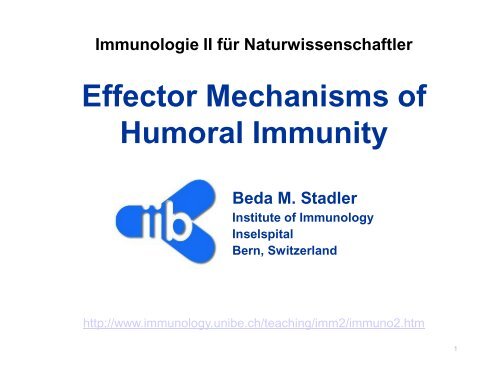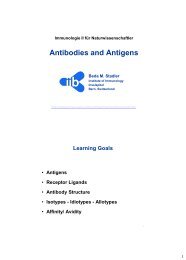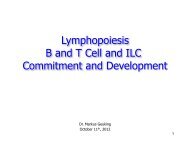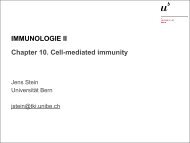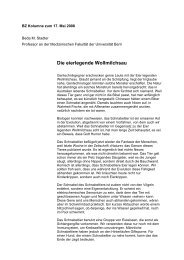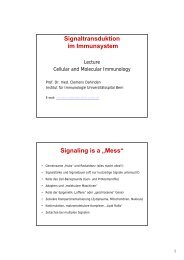B Zellen und Antigene - University Institute of Immunology
B Zellen und Antigene - University Institute of Immunology
B Zellen und Antigene - University Institute of Immunology
- No tags were found...
Create successful ePaper yourself
Turn your PDF publications into a flip-book with our unique Google optimized e-Paper software.
Immunologie II für NaturwissenschaftlerEffector Mechanisms <strong>of</strong>Humoral ImmunityBeda M. Stadler<strong>Institute</strong> <strong>of</strong> <strong>Immunology</strong>InselspitalBern, Switzerlandhttp://www.immunology.unibe.ch/teaching/imm2/immuno2.htm1
Learning Goals• Repetition• Effector functions <strong>of</strong> antibodies• Pathways <strong>of</strong> complement activation• MAC• Functions <strong>of</strong> complement• Mucosal Immunity2
Repetition• Antibodies are produced by B lymphocytes and plasma cells inthe lymphoid organs and bone marrow, but antibodies performtheir effector functions at sites distant from their production.• The antibodies that mediate protective immunity may be derivedfrom short-lived or long-lived antibody-producing plasma cellsfollowing the activation <strong>of</strong> naive or memory B cells• Many <strong>of</strong> the effector functions <strong>of</strong> antibodies are mediated by theheavy chain constant regions <strong>of</strong> Ig molecules, and different Igheavy chain isotypes serve distinct effector functions• Although many effector functions <strong>of</strong> antibodies are mediated bythe Ig heavy chain constant regions, all these functions aretriggered by the binding <strong>of</strong> antigens to the variable regions3
Effector Functions <strong>of</strong> Antibodies4
Human Antibody IsotypesIsotype <strong>of</strong>antibodySubtypes H chain Serumconcentr.(mg/mL)Serum half-life(days)IgA IgA1,2 α(1 or 2) 3.5 6IgD None δ Trace 3IgE None ε 0.05 2IgG IgG1-4 γ(1,2,3 or 4) 13.5 23IgM None μ 1.5 55
Functions <strong>of</strong> Antibody IsotypesAntibody Isotype-specific effector functionsIsotopeIgG• Opsonization <strong>of</strong> antigens for phagocytosis by macrophages andneutrophils• Activation <strong>of</strong> the classical pathway <strong>of</strong> complement• Antibody-dependent cell-mediated cytotoxicity mediated by naturalkiller cells• Neonatal immunity: transfer <strong>of</strong> maternal antibody across theplacenta and gut• Feedback inhibition <strong>of</strong> B cell activationIgM• Activation <strong>of</strong> the classical pathway <strong>of</strong> complement• Antigen receptor <strong>of</strong> naive B lymphocytes*IgA• Mucosal immunity: secretion <strong>of</strong> IgA into the lumens <strong>of</strong> thegastrointestinal and respiratory tracts• Activation <strong>of</strong> complement by the lectin pathway or by the alternativepathwayIgE• Mast cell degranulation (immediate hypersensitivity reactions)IgD• Antigen receptor <strong>of</strong> naive B lymphocytes**These functions are mediated by membrane-bo<strong>und</strong> and not secreted antibodies6
Neutralization <strong>of</strong> microbes and toxinsby antibodies7
Vaccine-Induced Humoral ImmunityInfectiousdiseasePolioTetanus,diphtheriaHepatitis, A or BPneumococcalpneumonia,HaemophilusVaccineOral attenuated poliovirusToxoidsRecombinant viralenvelope proteinsConjugate vaccinescomposed <strong>of</strong> bacterialcapsular polysaccarideand proteinMechanism <strong>of</strong> protectiveimmunityNeutralization <strong>of</strong> virus bymucosal IgA antibodyNeutralization <strong>of</strong> toxin bysystemic IgG antibodyNeutralization <strong>of</strong> virus bysystemic IgG antibodyOpsonization andphagocytosis mediated byIgM and IgG antibodies,directly or secondary tocomplement activation8
Durch Impfungen verhütbare Krankheiten:WHO-Ziele <strong>und</strong> aktuelle Lage in der SchweizKrankheit WHO-Ziel (Jahr) Aktuelle Lage in der Schweiz (1998–2001)Diphtherie Inzidenz 20 Jahren keine neonatalenFälle, gemeldete Tetanusfälle:2–4/Jahr (0,03–0,06/105/J.)Pertussis Inzidenz
Antibody-mediated opsonization andphagocytosis <strong>of</strong> microbes10
Antibody-dependent cell-mediatedcytotoxicity11
Fc Receptors12
The early steps <strong>of</strong> complement activation bythe alternative and classical pathways13
The alternative pathway <strong>of</strong>complement activation14
The classical pathway<strong>of</strong> complement activation15
C1 binding tothe Fc portions <strong>of</strong> IgM and IgG16
Late steps <strong>of</strong> complement activationand formation <strong>of</strong> the MAC17
Structure <strong>of</strong> the MAC in cellmembranes18
Functions <strong>of</strong> complement19
Mucosal <strong>Immunology</strong>Zilien Mucus MucusLungeSäure• Talg• pH• Schweiss• Lysozym• Magensaft• TransferrinDarmFettsäurenHautNorm. bakt. FloraHaarFollikel
Transport <strong>of</strong> IgA across epithelial cells21
IgA• Struktur– Serum - Monomer– Sekretion (sIgA)• Dimer (11S)• J chain• SekretorischeKomponenteEine B Zelle sekretiertentweder monomeres ordimeres IgA.22
IgA• Eigenschaften– 2. höchst im Serum– häufigstes Ig imKörper– bindet keinKomplement(ausser aggregiert)23
1224
IgA and Antiviral Defence25
IgA and Antibacterial DefenceIgA 2 is more proteaseresistant than IgA 1 .26
Learning Goals• Repetition• Effector functions <strong>of</strong> antibodies• Pathways <strong>of</strong> complement activation• MAC• Functions <strong>of</strong> complement• Mucosal Immunity27


